Soldier Story: Robert Toshi Kuroda
Soldier Story
Robert Toshi
Kuroda
2nd Battalion
H Company
Staff Sergeant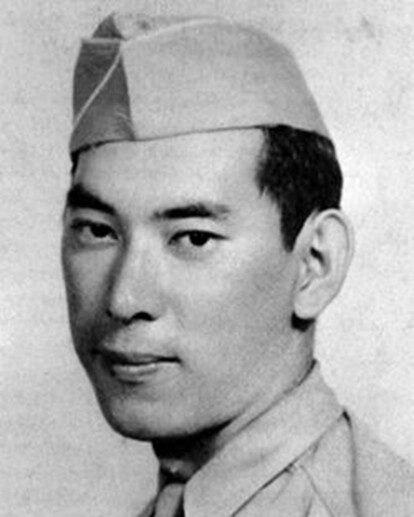
Robert Toshio Kuroda
Staff Sergeant
2nd Battalion, H Company
442nd Regimental Combat Team
Robert Toshio Kuroda was born on November 8, 1922, in Aiea, on the western side of Honolulu, Territory of Hawaii. His parents, Toyoichi and Sekino Kuroda, arrived in 1904 and 1907, respectively, from Hiroshima Prefecture, Japan. Toyoichi arrived on the S.S. Coptic on March 14, 1904. Sekino arrived on January 17, 1907, on the S.S. Korea.
Robert was one of nine children in the Kuroda family: brothers Hisao Mishima, Mineso Daniel, Donald Haruyuki, Ronald Haruto, Wallace Haruso, Joseph Toshiyuki, and sisters Tsuneko Lucille, Toshie Betty. The oldest son, Hisao Mishima, was born in Puunene, Maui, on January 25, 1908, to Sekino and her first husband, Kumaichi Mishima. Kumaichi arrived from the village of Yawata, Hiroshima Prefecture, on January 5, 1907, on the S.S. Korea, already married to Sekino. Her maiden name was not found in our research.
Toyoichi initially settled on Maui, where he was residing in April 1910 as an employee of the railroad in Kahului. Sekino and her son Hisao were lodging with him. At this time, Kumaichi Mishima was working on a sugar plantation in Niulii, Hawaii island. By the fall of 1910, Toyoichi and Sekino were married. By 1918, they had moved to Oahu and were living in Aiea when he signed his World War I draft card. He was employed as a boilermaker by the Honolulu Plantation Company.
In 1930, the family was living in Aiea and father Toyoichi was employed as a mill hand at the sugar mill. In 1940, their address was 2 Lanakapili Drive, Aiea. Toyoichi was the fire-room foreman at the sugar mill. In June that year, Robert graduated from Farrington High School. He then attended Honolulu Vocational School.
At the time of the attack on Pearl Harbor, Robert had just become a licensed electrician. He applied for work at Pearl Harbor, but was denied and – along with other persons of Japanese ancestry – declared an enemy alien. He then began working for the Hawaiian Plantation Company.
Robert signed his World War II draft registration card on June 30, 1942, Local Board No. 9, at August Ahrens School in Waipahu. His address was House No. 2 at Hawaiian Plantation Company’s Old Mill Camp in Waipahu, and his point of contact was his older brother Mineso Kuroda who lived in House No. 123, Mill Camp. He was 5’10” tall, weighed 135 pounds, and an employee of Hawaiian Plantation Company.
When the formation of the 442nd was announced in early 1943, Robert Kuroda volunteered. He asked his father to sign his papers, but his father refused on the grounds that there was already one Kuroda son serving – older brother Ronald was in the 100th Infantry Battalion (Separate) in training on the mainland. Robert told his mother that he wanted to go into the war to prove his loyalty – and when he returned that Pearl Harbor would have to hire him because, as he said, “I am an American.”
Robert enlisted in the U.S. Army on March 23, 1943, in Honolulu. His civilian occupation was given as “Electrician” and he had completed four years of high school. He was sent with the other 442nd volunteers to the “tent city” known as Boom Town at Schofield Barracks.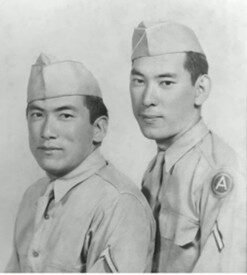
After the community aloha farewell ceremony at Iolani Palace on March 28, the new soldiers of the 442nd left on the S.S. Lurline on April 4 for Oakland, California. From there, the new 442nd soldiers went by train to Camp Shelby, Mississippi, arriving on April 13. Kuroda was assigned to H Company, the heavy weapons company of 2nd Battalion.
Right: Kuroda brothers, summer 1943 at Camp Shelby, after Robert’s arrival with the 442nd on April 13 and before Ronald’s departure with the 100th Infantry Battalion on August 11
Basic training began on May 10. On September 22, it was announced in the Honolulu Star-Bulletin that Robert had recently been promoted to Private First Class. After a year of basic, unit, and combat training and field maneuvers, he left Camp Shelby with the Combat Team by train on April 22, 1944, for Camp Patrick Henry, Virginia. The 442nd sailed from nearby Hampton Roads on May 2 in a convoy of over 100 ships. Before leaving the US, Robert had put in place plans for one-third of his $21 monthly Army pay to go toward the education of his youngest brother, Joe.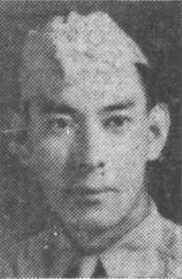
Once the ships carrying the Combat Team arrived in the Mediterranean on May 20, they headed to Naples, Italy, arriving on May 28 and proceeding to a bivouac at Staging Area No. 4 in nearby Bagnoli.
However, the U.S.S. Elbridge Gerry, which carried all of 2nd Battalion except Company E, had left the convoy shortly after passing the Strait of Gibraltar and headed for Oran, Algeria. In Oran, cargo was offloaded, and the 442nd soldiers went to Staging Area No. 2, a distance of 21 miles from the port. For the next two weeks the men performed various tasks such as guarding quartermaster supplies and Military Police vehicles. Finally, on June 5 they sailed on the British troopship HMT Samaria and arrived at Naples on June 9.
In the meantime, the 442nd had departed Naples on June 6, leaving behind 2nd Battalion’s E Company to await the 2nd Battalion’s arrival from Oran. The 442nd went by LSTs to Anzio, then trucked around Rome to Civitavecchia, 50 miles north.
The 2nd Battalion arrived at Naples on June 9, reunited with their E Company, and then spent the next two weeks at Bagnoli. They departed on June 15 by LSTs directly to Civitavecchia, where they met up with the rest of the Combat Team on June 17.
The 442nd, with Kuroda, entered combat on June 26, 1944, near Suvereto, in the Rome-Arno Campaign. After a series of battles relentlessly driving the enemy north to the Arno River, they were pulled from the lines and sent to Naples for shipment to France to join in the battles to drive the Nazis out of France. They arrived at Marseilles on September 29 after a 2-day voyage, and bivouacked at nearby Septèmes prior to traveling over 500 miles north by truck or rail boxcars to the Vosges – where they joined in the Rhineland-Vosges Campaign as part of the Seventh Army.
The Combat Team arrived at Charmant-devant-Bruyères on October 11. On October 14, the 442nd began moving into position in the late afternoon preparing for the assault on the German-held hills surrounding the important road and rail junction of Bruyères. The 442nd named these Hills A, B, C, and D. Each hill was heavily guarded by the Germans, as each was key to taking and securing the town. Hill A was located northwest of Bruyères, Hill B to the north, Hill C northeast, and Hill D to the east. [In French, Mt. Buemont, Mt. le Château, Mt. Pointhaie, and Mt. Avison.] The Vosges Mountains provided a very different terrain from what the 442nd had experienced in Italy. The unit – still in their summer uniforms – faced cold, dense fog, a lot of rain and mud, heavily forested hills, and intense enemy gunfire and artillery while moving through the Vosges Mountains. Hitler had ordered the German frontline to fight with no retreat in the Vosges, to prevent the Allied forces from breaking through into Germany.
On October 15, 1944, the 442nd began its attack on Bruyères. The 100th moved on Hill A, which was held by the SS Polizei Regiment 19, and the 2nd Battalion, with Kuroda, moved in on Hill B. Third Battalion was left to take the town of Bruyères. After four days of heavy fighting, the 100th took Hill A, 2nd Battalion was able to gain a toehold on Hill B, and 3rd Battalion pushed into the town itself. The next day, October 19, 2nd and 3rd Battalions were ordered to take Hill D, which they accomplished by midday. They then formed a salient of 2,000 yards into enemy territory. However, that night a strong force of about 100 Germans infiltrated back to Hill D, threatening the rear of 2nd and 3rd Battalions.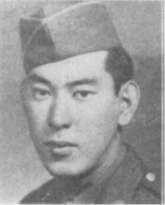
On the morning of October 20, the Germans on Hill D attacked a 2nd Battalion supply carrying party. In the fight to extract this group, S/Sgt. Kuroda led an attack on a machine-gun nest and some enemy riflemen. He was killed instantly in this action on Hill D when a sniper’s bullet struck him. S/Sgt. Takao Hedani, who witnessed the incident, later recalled, “We went to help the carrying party, but we got pinned down too. Robert and I spoke briefly, after which I left him. About 50 yards away, he was hit in the throat.” Takao and the squad went on to rescue the beleaguered carrying party.
S/Sgt. Robert T. Kuroda was buried at Épinal American Military Cemetery with the other 442nd soldiers killed in the Vosges, about 25 miles from Bruyères.
On November 12, 1944, the Kuroda family held two memorial services for their son Robert – at 1:00 p.m. in the Aiea Hongwanji Mission and at 3:00 p.m. in the Aiea Community Center. He was survived by his parents, six brothers, and two sisters. His brother Ronald was at the time with the 442nd RCT fighting in France and brother Wallace was with the 1399th Engineer Construction Battalion at Schofield Barracks. On November 18, the Kuroda family placed a Card of Thanks notice in the Honolulu Star-Bulletin to express their gratitude to the relatives and friends for the many kindnesses and floral offerings received at the memorial services.
For his wartime service, S/Sgt. Robert T. Kuroda was awarded the following: Medal of Honor (upgraded from Distinguished Service Cross), Bronze Star Medal, Purple Heart Medal, Good Conduct Medal, American Campaign Medal, European-African-Middle Eastern Campaign Medal with two bronze stars, World War II Victory Medal, Distinguished Unit Badge, and Combat Infantryman Badge. He was posthumously awarded the Congressional Gold Medal on October 5, 2010, along with the other men of the 442nd Regimental Combat Team. This is the highest Congressional Civilian Medal.
Kuroda’s Distinguished Service Medal, along with the medals of 20 other men, was upgraded to the Medal of Honor in a review of military awards in the 1990s. The Medal of Honor was presented to his brothers Ronald and Joe Kuroda by President Bill Clinton at a ceremony held in the White House on June 21, 2000. His Medal of Honor citation reads:
Leading his men in an advance to destroy snipers and machine gun nests, Staff Sergeant Kuroda encountered heavy fire from enemy soldiers occupying a heavily wooded slope. Unable to pinpoint the hostile machine gun, he boldly made his way through heavy fire to the crest of the ridge. Once he located the machine gun, Staff Sergeant Kuroda advanced to a point within ten yards of the nest and killed three enemy gunners with grenades. He then fired clip after clip of rifle ammunition, killing or wounding at least three of the enemy. As he expended the last of his ammunition, he observed that an American officer [1st Lieutenant Charles O. Farnum, Jr.] had been struck by a burst of fire from a hostile machine gun located on an adjacent hill. Rushing to the officer’s assistance, he found that the officer had been killed. Picking up the officer’s submachine gun, Staff Sergeant Kuroda advanced through continuous fire toward a second machine gun emplacement and destroyed the position. As he turned to fire upon additional enemy soldiers, he was killed by a sniper. Staff Sergeant Kuroda’s courageous actions and indomitable fighting spirit ensured the destruction of enemy resistance in the sector. Staff Sergeant Kuroda’s extraordinary heroism and devotion to duty are in keeping with the highest traditions of military service and reflect great credit on him, his unit, and the United States Army.
In 1948, the US began closing some of its overseas wartime military cemeteries. The remains of Americans buried overseas began slowly to return to the U.S. if the family so wished – and Kuroda’s family wanted his remains returned to Hawaii. His flag-draped casket, along with 77 others, arrived on the USAT Dalton Victory on September 1, when the ship docked at 1:00 p.m. at Pier 40 in Honolulu Harbor. This was the first of the ships to carry the remains of Hawaii’s war dead. The Coast Guard cutter U.S.C.G.C. Iroquois and the Navy destroyer escort U.S.S. George met the Dalton Victory off Diamond Head and accompanied it to the harbor. The deck of the Iroquois was lined with 442nd veterans who placed four giant wreaths – signifying the four main islands – made of anthuriums, roses, and orchids in the waters by the mortuary ship. As the ship entered the harbor, a 21-gun cannon salute boomed from Fort Armstrong. Flights of Army, Navy, and Marine planes performed a flyover above the funeral ship. Flags throughout the city were at half-mast, church bells tolled, and a memorial procession made its way through downtown from the pier to Iolani Palace. The caskets of two unnamed soldiers laid in state in the Throne Room of the Palace.
The remains of the soldiers were kept at the Army Mausoleum at Schofield Barracks pending individual burial arrangements by the families.
On July 27, 1949, S/Sgt. Kuroda was among 19 war dead buried at the National Memorial Cemetery of the Pacific at Punchbowl. He was buried at 3:00 p.m. in Section D, Site 92.
In 1957, the U.S. Army named the training area/parade ground at Fort DeRussy in Waikiki in honor of S/Sgt. Robert T. Kuroda. The dedication ceremony was held in conjunction with a luau at the Fort DeRussy Armory on September 28 at 5:30 p.m. Among the 500 attendees were Governor William F. Quinn, who served as guest speaker, Mayor Neal Blaisdell, and Representative John A. Burns. The memorial marker was unveiled by Kuroda’s father, Toyoichi Kuroda. Also present were Stanley M. Watanabe, 442nd Veterans Club President, Chaplain Hiro Higuchi (H Company), H Company President Takashi Okuhara, and H Company veteran 2nd Lieutenant Hideo Robert Kaichi, who placed a memorial lei on the historical marker.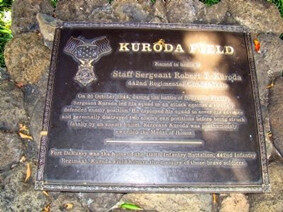
Above: Historical marker at Kuroda Field.
On May 21, 2003, the USAV SSGT Robert T. Kuroda (LSV-7), an Army logistics support ship, was christened in Pascagoula, Mississippi. Kuroda’s sister Betty Hill broke the traditional bottle of champagne across the bow at the ceremony. The ship is based at Pearl Harbor.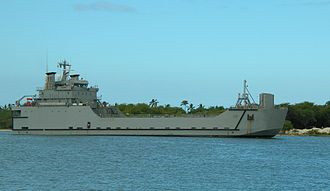
Above: USAV Kuroda in Pearl Harbor
In 2021, Robert Kuroda’s Farrington High School class ring was found buried 6-8 inches underground in the Vosges forest near Bruyères by Sebastién Roure, a metal detector hobbyist. It was returned in May 2022 to the Kuroda family when nephew Kevin Kuroda and his wife Mary Hammond travelled to Bruyères to accept it. This was especially poignant for the family as Robert Kuroda was the first in his family to graduate from high school. Engraved on the inside of the golden ring is R. Kuroda.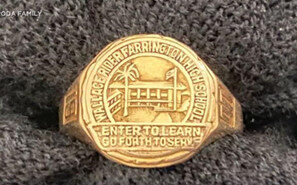
Brother Ronald Haruto Kuroda served in B Company, 100th Battalion, 442nd RCT. Brothers Wallace and Joseph also served in World War II.
Researched and written by the Sons & Daughters of the 442nd Regimental Combat Team in 2025.